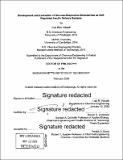Development and evaluation of glucose-responsive biomaterials as self-regulated insulin delivery systems
Author(s)
Volpatti, Lisa Rae.
Download1293027487-MIT.pdf (17.52Mb)
Other Contributors
Massachusetts Institute of Technology. Department of Chemical Engineering.
Terms of use
Metadata
Show full item recordAbstract
Motivation: Diabetes mellitus is a disease characterized by poor glycemic control which often leads to severe complications including cardiovascular disease and kidney failure Many diabetic patients must continually monitor their blood sugar and self-administer multiple daily doses of exogenous insulin to combat hyperglycemia To reduce this patient burden, limit the occurrence of hypoglycemic events, and better mimic native insulin activity, therapies which can self-regulate insulin delivery are an attractive option This work begins to address current limitations of such glucose-responsive insulin delivery systems by developing novel biomaterial-based formulations Results This Thesis presents 3 types of glucose-responsive insulin delivery systems developed during my PhD Each system employs the enzyme glucose oxidase as a glucose sensor, which converts glucose to gluconic acid and reduces the pH of the microenvironment when glucose levels are high. This change in pH acts as a trigger to release insulin on demand The first system uses the pH-responsive polymer acetalated-dextran to formulate nanoparticles that physically encapsulate both insulin and glucose oxidase The particles rapidly degrade in the presence of acid, making this system a fast acting therapeutic that reduces blood sugar within an hour of administration in diabetic mice The second system is comprised of alginate microgels that encapsulate nanoparticles to create a depot of insulin for sustained glucose-responsive release in vivo for over 3 weeks with just 2 doses. The third system is based on the electrostatic complexation of insulin to positively charged polymers, such as polyethyleneimine When the pH is reduced below the isoelectric point of insulin, the complex dissociates and releases insulin only in response to elevated levels of glucose. These complexes are afforded a prolonged functional lifetime by decreasing the rate of insulin release under normal glucose concentrations The synthesis, formulation, in vitro characterization, and in vivo results in diabetic mouse models for each of these systems are discussed Conclusion: The development and characterization of the glucose-responsive insulin delivery systems described here marks an important step in the advancement of self-regulated insulin delivery. Furthermore, these formulations may provide generalized strategies for the development of future stimuli-responsive drug delivery systems.
Description
Thesis: Ph. D., Massachusetts Institute of Technology, Department of Chemical Engineering, February, 2020 Cataloged from the official PDF of thesis. Includes bibliographical references (pages 123-131).
Date issued
2020Department
Massachusetts Institute of Technology. Department of Chemical EngineeringPublisher
Massachusetts Institute of Technology
Keywords
Chemical Engineering.